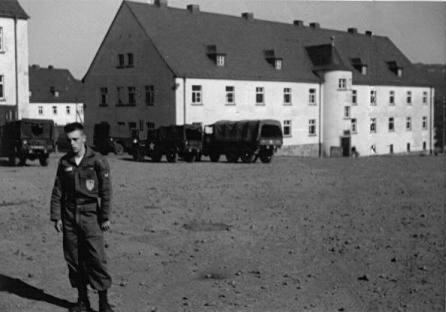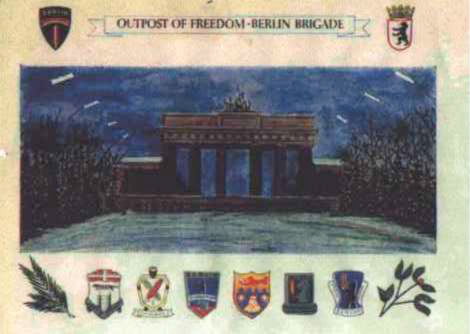This page contains some of my notes about the 12th Infantry before Vietnam. It is offered in its incomplete form for educational purpose. -b.h.
Post World War II and Cold War
EXTRACT FROM 1963 1st DIVISION YEARBOOK:
“The current 2nd Battle Group, 12th United States Infantry was brought together as a new unit for intensified Advanced Individual Training in the middle of September 1961, as a result of the crisis created in Berlin by construction of the infamous “Wall” which divided that city. Personnel assigned to the 12th Infantry at tis time had received only abbreviated courses of basic training, and cadre called in had in many cases been on civilian component duty or away from regular infantry units for a long period of time.
Orders were received by Colonel George Pinard, then the 12th Infantry’s Commanding Officer, that theBattleGroup would undergo training which would make the unit a combat ready force in the shortest possible time, with the first part of December as the target date for this readiness. It was going to be a true test for leadership and adjustment by all.
The sudden death of Colonel Pinard, resulting from a heart attack during a field training exercise in mid-October 1961, placed Lieutenant Colonel George P. Welch, the Deputy Battle Group Commander in charge of the 12th Infantry.
With the end of October came completion of AIT for the 12th Infantry and the beginning of Basic Unit Training with its attendant Army Training Tests. Climax of BUT came with the Battle Group making a 500 mile motor march to Tarryall, Colorado under command of Lt. Col. Welch for its ATT during the period 27 November to 10 December 1961.
On December 11th, 1961, with the successful completion of the training tests, the 12th Infantry went into Operational Readiness Training status. Continuous field training combined with unannounced alerts honed the Battle Group to a fine edge, as it joined the ranks of the other combat ready forces in the 1st Infantry Division.
1 February 1962 saw Colonel Thomas J. Cleary, Jr. take command of the 12th Infantry and prepare it for more ambitious tasks: Exercise “Red Arrow” and Long Thrust IV.
Results of Exercise “Red Arrow,” during the period 17-20 April 1962, showed the 12th Infantry as an outstanding unit of the 1st Infantry Division. Achievements during Red Arrow influenced the choosing of the 12th Infantry to initiate the 1st Divisions participation in the Long Thrust exercises.
Formed into a Task Force with addition of support units from the 7th Artillery, 9th Transportation Battalion, 1st Aviation Company and 701st Ordnance, the 12th Infantry was assigned Long Thrust IV, destined to depart for Germany in July 1962.
Flown from Forbes AFB in Topeka, Kansas, Task Force 2/12 arrived at Rhein-Main AFB near Frankfurt, Germany, to begin a highly successful series of maneuvers and missions during its forthcoming six-month stay in Germany.
After drawing equipment at a staging area in the woods near Karlshruhe, Germany, the Warriors proceeded on a tactical motor march to Wildflecken, where they terminated the initial phase of LongThrust IV in a rugged test of combat readiness by a swift moving attack against the seasoned troops of the 504th Airborne.
Quickly adjusting to the situation in Germany, the 12th Infantry settled down in Wildflecken and carried on with its mission of remaining combat ready. Intense field training, coupled with short-reaction-time alerts, showed the 12th Infantry as a unit which the 1st Division could be proud of. Esprit moved to higher levels than ever before, and the 12th Infantry became a truly cohesive unit, proud in garrison and tough in the field.
Word was received in September 1962 that the 12th Infantry would move from Wildflecken to Berlin. This would mark it as the first unit of the “Big Red One” to enter that city and help reassert the right of free access by the United States Forces.
Last elements of the 12th Infantry closed into Berlin on September 24th. The 12th Infantry was at last able to see first hand the need for its being. Under the ever watching eyes of the Russians, the “Wall” and borders around the American Sector of Berlin.
Departure from Germany and termination of Lon Thrust IV began the first week of January 1963, with the move from Berlin by the Task Force 2/12 to a staging area at Spinelli Barracks in Mannheim. Here equipment drawn in Germany was turned back in and the Task Force made its long, non-stop flight back to Kansas.
After taking a brief, but well-earned rest upon its return to Fort Riley, the 12th Infantry found itself faced with the mission of supporting the rifle and pistol matches to be held at Fort Riley, during the Spring of 1963, with Colonel Cleary named as match Executive Officer. The Fort Riley/1st Division Matches in March started the season, while completion came with the Fifth Army Matches ending April 28th.
Resumption of Operational Readiness Training is currently underway by the 12th Infantry, with training aimed at preparation for the 1963 Army Training Tests.
[Source: 1st Division Yearbook extract supplied by Charlie Moy, Alpha Co.]
BERLIN
“The closest I came to war was the Cuban Missile Blockade. We were in Berlin, Germany on a training mission “Operation Long Thrust.” Three months in Wildflecken (war games) and four months in Berlin; parades, guard duty and PARTY TIME!!
Suddenly we were put on full alert. We were to defend Templehof Airport “For as long as possible.” We were located 110 miles inside East Germany (Communist territory) surrounded by 55 Russian Armored Divisions. Life expectancy approx. 60 min.
That was as scary as it got for Co. A, 2/12th, 1st Division.” [Source: Charlie Moy Email]
Alpha Co. at Andrews Barracks, and others at McNair Barracks. [Source: Moy]Charlie Moy outside barracks at Wildfecken, Germany during ‘Operation Long Thrust.’

Note the 12th Infantry “pocket patch” on Charlie’s uniform.
1962 Berlin Brigade Christmas Card

“In Berlin. My unit [Co. D, 2nd BG, 12th Infantry, 1st Division] pulled alerts along the wall and the Spree River. It was the cold war all right, we were under orders not to return fire. There were a few East Berliners that might have made it if we had disobeyed those orders. It is hard to stand by with an M-60 and see a [East German] body wash up on the shore….” [Source: Fred Sanford]